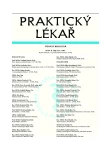Atrial fibrillation and electrical cardioversion in the outpatient cardiology department
Authors:
D. Nováková; F. Toušek; A. Bulava; M. Jelínek; M. Vácha
Authors‘ workplace:
Kardiocentrum – kardiologie, Nemocnice České Budějovice, a. s., Primář: MUDr. František Toušek, FESC.
Published in:
Prakt. Lék. 2010; 90(7): 433-435
Category:
Therapy
Overview
The most common arrhythmia is atrial fibrillation. In the outpatient clinic we have to deal with and treat patients attending with this diagnosis as best we can on a routine daily basis. Our procedure and method of treatment depends mainly on the symptoms and time of onset and duration of atrial fibrillation. Patients with symptoms of heart failure and coronary insufficiency are admitted to the coronary unit, whilst the remaining patients with less severe symptoms can be treated in Day Care Unit. In both cases, we have to make a decision if the method of treatment is to control the rhythm (i.e. pharmacologically or electrical cardioversion) or control the heart rate. In a group of elderly and less symptomatic patients both strategies have equal outcomes according to the latest studies. Synchronized electrical cardioversion offers a reliable, effective and safe control and treatment of rhythm; it is still the treatment of choice despite the recent boom in radiofrequency ablations. The article presents a sample of patients treated with electrical cardioversion in the outpatient clinic over the course of one calendar year.
Key words:
atrial fibrillation- electrical cardioversion.
Sources
1. Calkins, H., Brugada, J., Packer, D.L., Cappato, R., Chen, S.A. et al. HRS/EHRA/ECAS expert Consensus Statement on catheter and surgical ablation of atrial fibrillation: recommendations for personal, policy, procedures and follow-up. A report of the Heart Rhyhtm Society (HRS) Task Force on catheter and surgical ablation of atrial fibrillation. Heart Rhytm. 2007, 4, p. 816-861.
2. Friberg, J., Scharling, H., Gadboll, N. et al. Sex-specific increase in the prevalence of atrial fibrillation (the Copenhagen City Heart Study). Am. J. Cardiol. 2003, 92, p. 1419-1423.
3. Fuster, V., Rydén, L.E., Cannom, D.S. et al. ACC/AHA/ESC 2006 guidelines for the management of patients with atrial fibrillation. A report of the American College of Cardiology/American Heart Association Task Force on Practice Guidelines and the European Society of Cardiology Committee for Practice Guidelines. Circulation 2006, 114, p. ,257-354.
4. Go, A., Hylek, E., Philips, K. et al. Prevalence of diagnosed atrial fibrillation in adults: national implication for rhythm management and stroke prevention: the anticoagulation and risk factor in atrial fibrillation (ATRIA) study. JAMA 2001, 285, p. 2370-2375.
5. Kannel, W., Abbot, R., Sabate, D. et al. Epidemiologic features of chronic atrial fibrillation: The Framingham study. N. Engl. J. Med. 1982, 306, p. 1018-1022.
6. Kopecky, S., Gersh, B., McGoon, M. et al. The natural history of lone atrial fibrillation. A population-based study over three decades. N. Engl. J. Med. 1987, 317, p. 669-674.
7. Lukl, J. a kol. Fibrilace síní. 1. vydání. Praha: Grada Publishing, 2009, s. 99-117.
8. The ACTIVE Writing Group on behalf the ACTIVE Investigators. Clopidogrel plus aspirin versus oral anticaogulation for atrial fibrilation in the atrial fibrillation Clopidogrel Trial with Irbesartan for preventiv of Vascular Events (ACTIVE W): a randomised controlled trial. Lancet 2006, 367, p. 1903-1912.
Labels
General practitioner for children and adolescents General practitioner for adultsArticle was published in
General Practitioner

2010 Issue 7
- Memantine Eases Daily Life for Patients and Caregivers
- Metamizole vs. Tramadol in Postoperative Analgesia
- Metamizole at a Glance and in Practice – Effective Non-Opioid Analgesic for All Ages
- Memantine in Dementia Therapy – Current Findings and Possible Future Applications
- What Effect Can Be Expected from Limosilactobacillus reuteri in Mucositis and Peri-Implantitis?
Most read in this issue
- Strabismus surgery in adults – yes or no?
- Liver transplantation in children
- Atrial fibrillation and electrical cardioversion in the outpatient cardiology department
- Asplenic patient – responsibility of all of us
